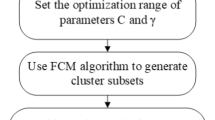Abstract
Ball mill of thermal power plant has high energy consumption and the grinding capability is usually used for representing the efficiency of ball mill. This paper proposes a density clustering analysis method of fuzzy neural network initialization for grinding capability prediction of power plant ball mill. The proposed method integrates the density clustering algorithm and the fuzzy neural network to predict grinding capability, where the density clustering algorithm is used to initialize the rules base of the fuzzy neural network. Furthermore, two parameters of the density clustering analysis can be determined by calculation formula, and the structure of the proposed model could be optimized by the training capability of neural network. The experiments are performed on two datasets obtained from the thermal power plant under the stable conditions. The experiments results verify that the proposed model has higher effectiveness. In addition, the proposed model has been put into practice and the field operation curve proves that the grinding capability could be predicted correctly.




Similar content being viewed by others
References
Akbar E, Werya A (2010) Adapted neuro-fuzzy inference system on indirect approach TSK fuzzy rule base for stock market analysis. Expert Syst Appl 37(7):4742–4748
Bezdek JC (1981) Pattern recognition with fuzzy objective function algorithms. Plenum Press, New York
Byung-In C, Frank CHR (2009) Interval type-2 fuzzy membership function generation methods for pattern recognition. Inf Sci 179(13):2102–2122
Deyin M, Yanchun L, Xiaoshe Z, Renchu G, Xiaohu S (2013) Multi-BP expert system for fault diagnosis of power system. Eng Appl Artif Intell 26:937–944
Dunn JC (1973) A fuzzy relative of the ISODATA process and its use in detecting compact well-separated clusters. J Cybern 3(3):32–57
Hannes V, Hannes V, Martine DC, Raymond B (2006) Fuzzy versus quantitative association rules: a fair data-driven comparison. IEEE Trans Syst Man Cybern 36(3):679–684
Hong Z, MingHui Z (2005) A neural intellectual decoupling control strategy for a power plant ball miller. Int J Autom Comput 2(1):43–47
Jiesheng W, Yong Z (2008) PID-ANN decoupling controller of ball mill pulverizing system based on particle swarm optimization method. 2008 Chinese Control and Decision Conference, Yantai, China; 1424–1428
Joaquín D, Salvador G, Daniel M, Francisco H (2011) A practical tutorial on the use of nonparametric statistical tests as a methodology for comparing evolutionary and swarm intelligence algorithms. Swarm Evol Comput 1(1):3–18
Jyh-Shing RJ (1993) ANFIS: adaptive-network-based fuzzy inference system. IEEE Trans Syst Man Cybern 23(3):665–684
Lianfei Z, Tianyou C (2006) Nonlinear decoupling PID control using neural networks and multiple models. J Control Theory Appl 4(1):62–69
Lixin J, Xinzhong L (2000) Self-optimization combined with fuzzy logic control for ball mill. Int J Comput Syst Signals 1(2):231–239
Meena T, Smriti S (2010) A new Kernelized hybrid c-mean clustering model with optimized parameters. Appl Soft Comput 10(2):381–389
MuYen C (2013) A hybrid ANFIS model for business failure prediction utilizing particle swarm optimization and subtractive clustering. Inf Sci 220:180–195
Pang-Ning T, Michael S, Vipin K (2006) Introduction to data mining. Addison Wesley Higher Education, USA
Patricia M, Martha P (2014) Optimization of ensemble neural networks with type-2 fuzzy integration of responses for the dow jones time series prediction. Intell Automat Soft Comput 20(3):403–418
Peng Y, Guoqing C (2006) Fuzzy quantitative association rules and its applications. Fuzzy Appl Ind Eng 201:573–587
Qiming C, Yinman C, Yong Z, Mingmei W (2009) PID control system for ball mill based on fuzzy radial basis function neural network. Proc CSEE 29(35):22–28
Quansheng D, Jizhen L, Zhifang W (2008) Design and experimental study on the pulverized coal concentration sensor based on γ-ray absorption method. Proceedings of 2008 I.E. Pacific-Asia Workshop on Computational Intelligence and Industrial Application 901–906
Tianyou C, Heng Y (2005) Multivariable intelligent decoupling control system and its application. Acta Automat Sin 31(1):123–131
Xia C, Hongli H, Zhihong L (2009) A pulverized coal concentration measurement system based on capacitance sensor. Proceedings of 2009 International Technology and Innovation Conference 1–4
Yager R, Filev D (1994) Generation of fuzzy rules by mountain clustering. J Intell Fuzzy Syst 2(3):209–219
Yiming T, Guosun Z, Lihua Y (2013) Energy analysis for an executable program on a single computer based on BP neural network. J Exp Theor Artif Intell 25(1):105–117
Acknowledgments
This work is supported by National High-tech Research and Development Projects (863) 2006AA04Z180.
Author information
Authors and Affiliations
Corresponding author
Rights and permissions
About this article
Cite this article
Jiang, R., Wang, Y. & Yan, X. Density clustering analysis of fuzzy neural network initialization for grinding capability prediction of power plant ball mill. Multimed Tools Appl 76, 18137–18151 (2017). https://doi.org/10.1007/s11042-016-4089-4
Received:
Revised:
Accepted:
Published:
Issue Date:
DOI: https://doi.org/10.1007/s11042-016-4089-4




